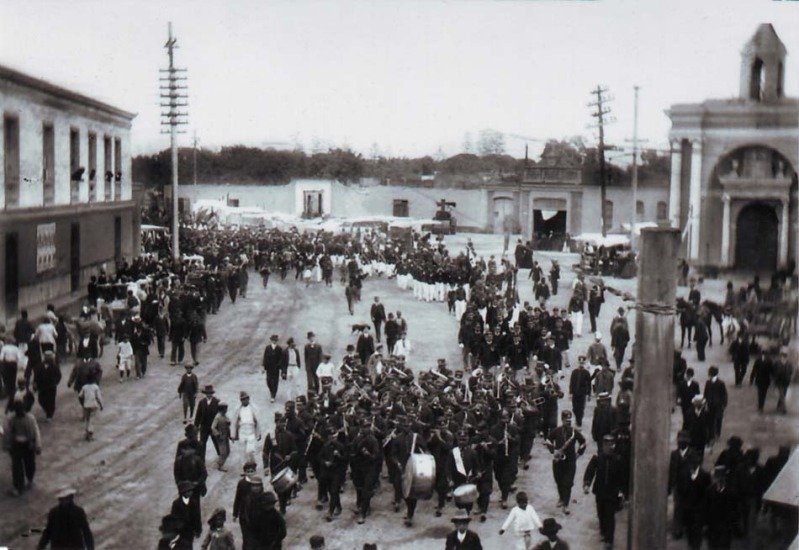
Santo Cristo Lima, Peru: Visiting Hours, Tickets, and Historical Sites Guide
Date: 15/06/2025
Introduction
Nestled in Lima’s historic Barrios Altos district, the Church of the Holy Christ of Wonders—commonly known as Santo Cristo—is a cornerstone of Peru’s religious, cultural, and architectural heritage. Founded in the early 18th century, this neoclassical sanctuary reflects Lima’s colonial past and its dynamic blend of European and local traditions. Today, Santo Cristo continues to serve as both a center of worship and a cultural touchstone, drawing pilgrims, historians, and travelers alike to its storied halls. This detailed guide explores the church’s history, visitor information, and nearby attractions, helping you make the most of your visit to one of Lima’s most cherished landmarks (Wikipedia: Iglesia del Santo Cristo de las Maravillas, Peru Info: Señor de los Milagros, Lonely Planet, Salterton Arts Review).
Table of Contents
- Introduction
- Early Origins and Historical Setting
- Community and Devotional Life
- Architectural and Artistic Heritage
- Religious Traditions and Major Events
- Visiting Hours, Tickets, and Guided Tours
- Accessibility, Safety, and Visitor Tips
- Nearby Attractions and Itineraries
- Frequently Asked Questions (FAQ)
- Conclusion
- References
Early Origins and Historical Setting
Santo Cristo was established in the early 1700s, during a period of urban expansion and religious consolidation in colonial Lima. The church quickly became a central point of devotion, especially for the diverse residents of Barrios Altos—a neighborhood historically home to Afro-Peruvian, indigenous, and Spanish communities. This cultural mix shaped the church’s traditions and its role as a community sanctuary (Wikipedia: Iglesia del Santo Cristo de las Maravillas).
Community and Devotional Life
One of the church’s most notable historical figures is Andrés de Jesús, a free man of color who played a key role in fostering local devotion by collecting alms for the Santo Cristo image. The church’s location at Avenida Sebastián Lorente and Jirón Áncash placed it near the Cementerio Presbítero Maestro, making it an important site for funeral processions and spiritual life throughout the 18th and 19th centuries.
Architectural and Artistic Heritage
Santo Cristo exemplifies neoclassical architecture, with clean lines and symmetrical forms that contrast with Lima’s more ornate baroque churches. Inside, the revered Santo Cristo statue remains a focal point, surrounded by ex-votos and religious artworks. The church’s artistic legacy includes colonial paintings, gilded altarpieces, and indigenous motifs woven into Christian iconography (Wikipedia: Iglesia del Santo Cristo de las Maravillas).
Religious Traditions and Major Events
Santo Cristo is part of Lima’s vibrant religious life, especially during the annual Señor de los Milagros procession—the largest Catholic gathering in Peru. While the main event centers on the Sanctuary of the Nazarenas, Santo Cristo maintains its own neighborhood-rooted celebrations, with processions, music, and traditional foods (Peru Info: Señor de los Milagros).
Visiting Hours, Tickets, and Guided Tours
- Visiting Hours: Typically open from 9:00 AM to 6:00 PM, Monday through Saturday. Hours may vary during festivals or special events.
- Entry Fee: Admission is free; donations are welcomed to support church maintenance.
- Guided Tours: Local tour operators and the church occasionally offer guided visits, especially during special occasions. Advance booking is recommended for English-language tours.
Accessibility, Safety, and Visitor Tips
Accessibility
- The church is accessible via public transport and is within walking distance of central Lima.
- Cobblestone streets may pose challenges for those with limited mobility; inquire ahead about accessibility accommodations.
Safety
- Visit during daylight hours, especially in Barrios Altos.
- Use authorized taxis or ride-hailing apps like Beat or Uber. Avoid street-hailing taxis (Lonely Planet).
- Be cautious with valuables and avoid isolated areas, especially after dark.
- As of June 2025, Lima is under a State of Emergency, with increased police presence and ID checks (UK Government Travel Advice).
Health and Hygiene
- Drink bottled or filtered water.
- Choose reputable places to eat or join guided food tours (Destinationless Travel).
- Carry hand sanitizer and small bills for public restrooms.
Dress and Behavior
- Dress modestly (cover shoulders and knees).
- Maintain silence during services and ask before photographing inside.
Nearby Attractions and Itineraries
- Plaza Mayor: Lima’s main square, home to the Government Palace and Cathedral.
- Cementerio Presbítero Maestro: Historic cemetery with elaborate mausoleums.
- San Francisco Monastery: Renowned for its baroque architecture and catacombs.
- Museo de la Inquisición: Insight into Peru’s colonial religious history.
- Artisan Markets: Nearby, offering traditional crafts and religious icons.
Incorporate Santo Cristo into a walking tour of Lima’s historic center for a richer experience (Breathing Travel: Where to Stay in Lima).
Frequently Asked Questions (FAQ)
Q: What are Santo Cristo’s visiting hours?
A: Generally, 9:00 AM–6:00 PM, Monday to Saturday. Confirm locally for any changes.
Q: Is there an entry fee?
A: No, entry is free. Donations are appreciated.
Q: Are guided tours available?
A: Yes, particularly during festivals or through local operators. Book in advance for English tours.
Q: Is the church accessible for people with mobility issues?
A: Some areas may be challenging due to steps and cobblestones.
Q: Can I take photos inside?
A: With permission, especially outside of services.
Q: Is the area safe for tourists?
A: Generally, yes during daylight and with precautions. Avoid isolated streets and keep valuables secure.
Conclusion
A visit to Santo Cristo de las Maravillas is more than a tour of a historic church—it’s an immersion into Lima’s centuries-old traditions, artistry, and resilience. Free admission, proximity to major landmarks, and opportunities for guided exploration make it one of Lima’s essential religious and cultural destinations. Plan your visit during open hours, respect local customs, and use guided audio tours or local guides for deeper insight. Through your visit, you contribute to the appreciation and preservation of Lima’s rich spiritual and historical legacy.
References
- Wikipedia: Iglesia del Santo Cristo de las Maravillas
- Peru Info: Señor de los Milagros
- Lonely Planet
- Salterton Arts Review
- Breathing Travel: Where to Stay in Lima
- UK Government Travel Advice
- Destinationless Travel














































































































